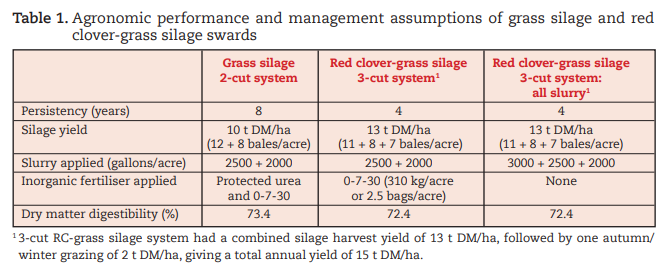Considering Red Clover Silage
Considering Red Clover Silage 20 December 2022 Type Media Article By Colm Kelly, B&T Drystock Adviser, Teagasc, Galway/Clare The rise in input costs has heightened interest in lowering chemical N inputs. One consideration is introducing red clover to silage fields in particular. Red clover has a poor persistency relative to white clover and under grazing […]
By By Colm Kelly, B&T Drystock Adviser, Teagasc, Galway/Clare
Considering Red Clover Silage
Type Media Article
By Colm Kelly, B&T Drystock Adviser, Teagasc, Galway/Clare
The rise in input costs has heightened interest in lowering chemical N inputs. One consideration is introducing red clover to silage fields in particular. Red clover has a poor persistency relative to white clover and under grazing conditions the growing point which is above ground can be damaged. Due to its growth habit red clover suits silage focussed swards and under good management it is likely to persist at good levels for 3-4 years. The root structure is also deeper than white clover through a tap root which gives it better drought tolerance in dry summers. The main reasons cited for low uptake to date is the short persistency window, the higher level of management required and its challenges with frequent grazing.
Red clover can be sown as a monoculture (red clover only) but for grassland farmers it is preferable to sow within a standard grass and white clover mix. In practice over the first six years of this reseed the red clover percentage will decline. It is recommended to have a 4 year break between red clover crops to prevent the build-up of disease issues. In a 10 year grassland reseeding rotation this leaves 4 years where the sward will be predominately grass with white clover which serves as the disease break. The white clover portion can be boosted with over-sowing during this period. This field can then be reseeded again with the red clover mix for another 10 year cycle. The important factors with clover is to target sites that are well drained and have a pH of 6.5-7 to get good establishment and persistence. Phosphorus (P) and Potassium (K) need to be index 3 to ensure good return on investment and ensure survivability of clover. Declines in P & K levels should be guarded against by ensuring offtakes are replaced through slurry or compound fertilisers such as 0-7-30. Weed control is important to get right at the post-emergence stage with an available clover safe product. Allowing weeds such as docks get established in a sward makes control extremely difficult and so is particularly time critical to get right at reseeding. High red clover swards (75% +) have been shown to potentially fix in excess of 200 kgs N/Ha which provides a financial benefit in chemical N savings but also Greenhouse gas and ammonia emission reductions.
The red clover sward is most suited to three cut silage systems with the first cut taken in mid-May with one grazing in the Autumn. The clover plant is sensitive to chemical N so where it is applied the percentage clover will likely decline. Red clover swards can cause issues with conception rates in sheep as the plant contains varying amounts of phyto-oestrogens so it is recommended not to graze 6 weeks either side of mating. It is a more challenging crop to ensile particularly if there is a high percentage clover in the sward. At harvesting red clover silage generally requires a 24-48 hour wilt in dry conditions. Over wilting can lead to leaf shatter issues. Clover can also pose problems for conservation as it has a low level of water soluble sugars and so the grass proportion of the sward can make an important contribution to helping preservation occur.
Silage intakes in cattle offered a red clover silage are likely to be higher and this can increase performance. Trials on monoculture red clover silage showed higher intakes compared to grass silage. In practice high red clover swards are generally managed using little or no Nitrogen fertiliser. In these conditions the crude protein content is generally similar to conventional silage receiving chemical Nitrogen. Multiple factors such as cutting date, proportion of red clover and digestibility influence eventual crude protein percentage. Where animals are to graze high percentage clover swards precautions will have to be taken for bloat.
To summarise sowing a mix with red clover inclusion is likely to suit fields that are primarily targeted for silage:
- Lowers chemical N costs
- Requires attention to detail
- May increase intake and improve performance
- Reduces Greenhouse gas and ammonia emissions

Information within this article is sourced from Teagasc National Beef Conference 2022 proceedings, Solohead Research Farm and Teagasc Organic Red Clover guide for further reading.

Red clover within silage sward a significant Nitrogen contributor
